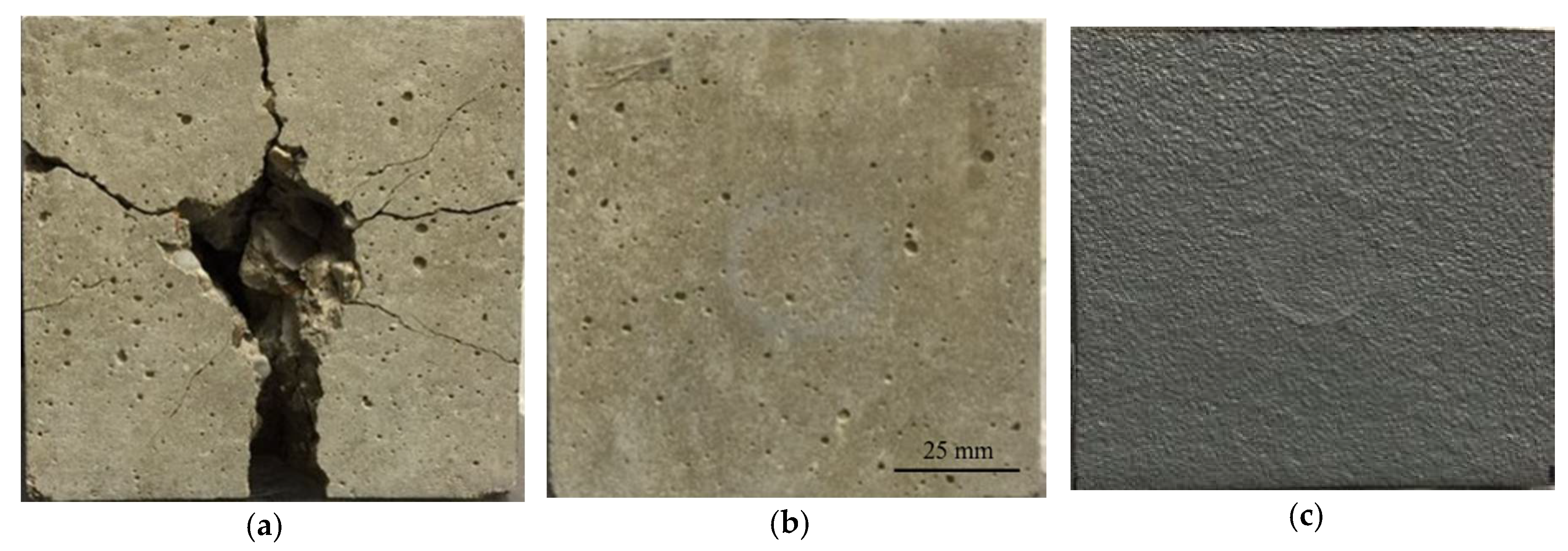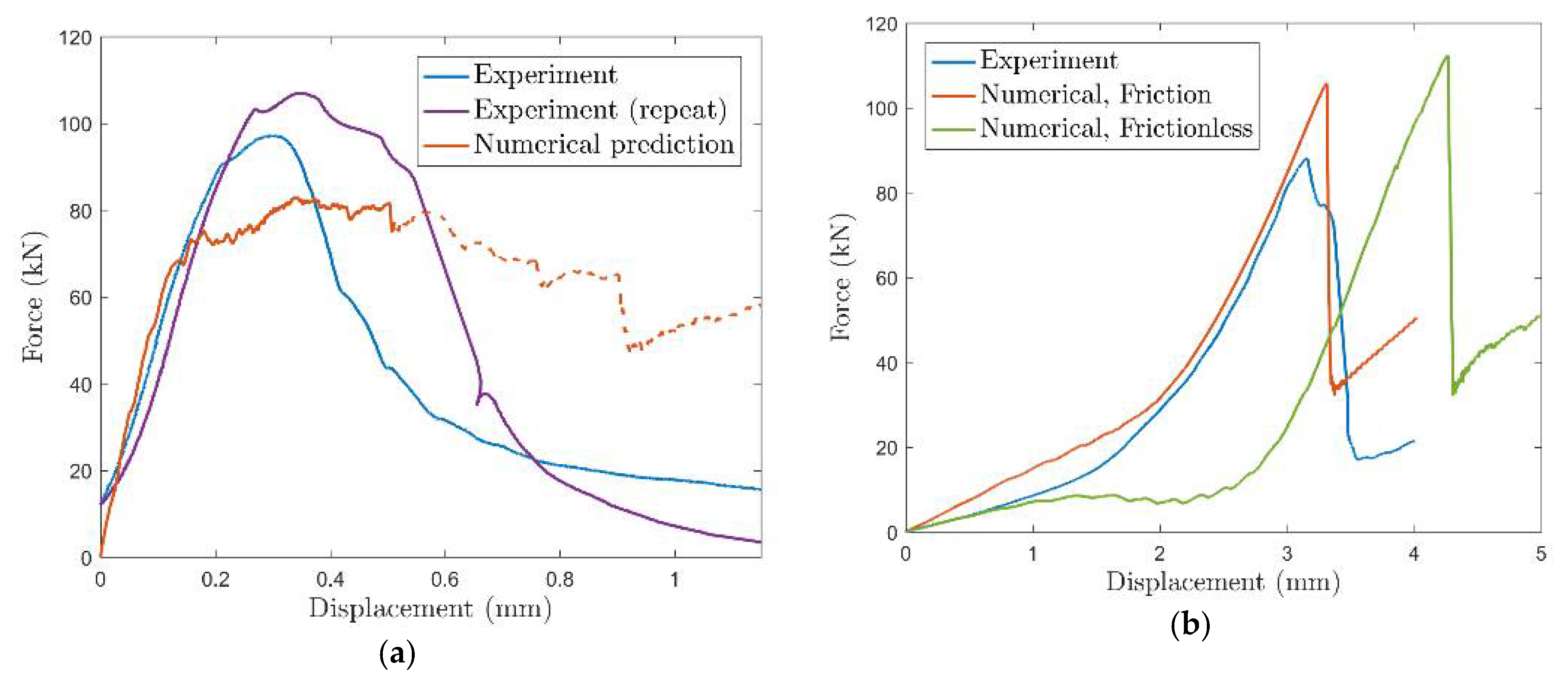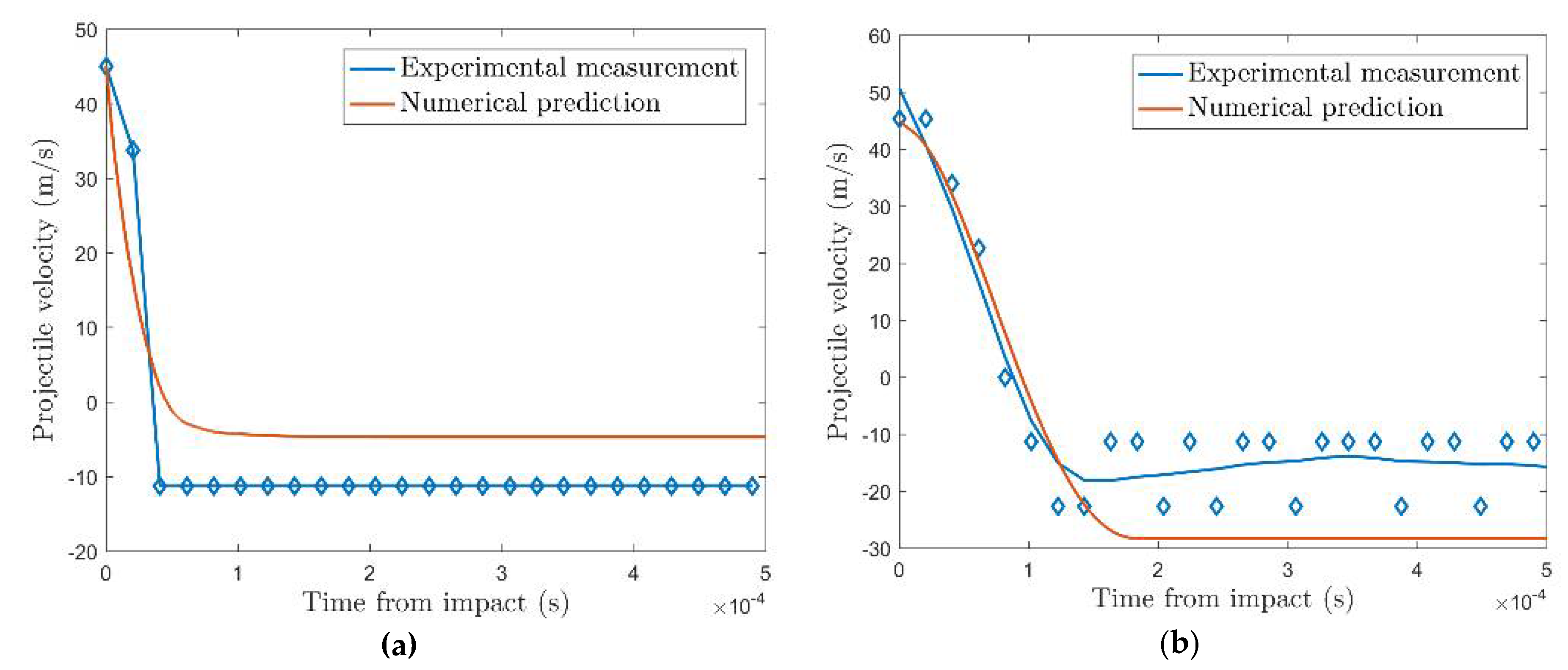Experimental and Numerical Investigation on the Impact Response of Elastomer-Coated Concrete †
Abstract
:1. Introduction
2. Experimental Investigation
2.1. Methodology
2.2. Results and Discussion
3. Numerical Investigation
3.1. Numerical Model Development
3.2. Numerical Modelling Challenges
3.2.1. Mesh Sensitivity and Corner Radius
3.2.2. Indentation Strength and Damage Response
3.2.3. Contact Conditions
3.2.4. Elastomer Hysteresis
3.3. Numerical Modelling of Dynamic, Impact Indentation
4. Conclusions
- The experimental investigation shows clearly that the presence of a thin elastomer coating can significantly reduce the damage experienced by a concrete cube subjected to projectile impact at velocities in the range 45–150 m/s.
- Quasi-static indentation experiments on coated and uncoated concrete cubes highlight some of the key challenges faced with numerical modelling of this complex problem. These include: material variability, predicting damage evolution and mesh sensitivity.
- A numerical model of the dynamic impact tests is validated against experimental measurements. Particularly good agreement is achieved for early time steps, before the concrete becomes severely damaged.
- This numerical modelling strategy provides an effective tool for studying the early stages of damage initiation and propagation. It will be employed in future work to better understand the mechanisms by which the elastomer coating achieves its mitigating effect.
Author Contributions
Acknowledgments
Conflicts of Interest
References
- Davidson, J.S.; Porter, J.R.; Dinan, R.J.; Hammons, M.I.; Connell, J.D. Explosive testing of polymer retrofit masonry walls. J. Perform. Constr. Facil. 2004, 18, 100–106. [Google Scholar] [CrossRef]
- Amini, M.R.; Isaacs, J.; Nemat-Nasser, S. Investigation of effect of polyurea on response of steel plates to impulsive loads in direct pressure-pulse experiments. Mech. Mater. 2010, 42, 628–639. [Google Scholar] [CrossRef]
- Raman, S.N.; Ngo, T.; Mendis, P.; Pham, T. Elastomeric Polymers for Retrofitting of Reinforced Concrete Structures against the Explosive Effects of Blast. Adv. Mater. Sci. Eng. 2012, 2012, 754142. [Google Scholar] [CrossRef]
- Fallon, C.; McShane, G.J. Regime mapping the blast response of elastomer-coated concrete. 2018. in preparation. [Google Scholar]
- Xue, L.; Mock, W.; Belytschko, T. Penetration of DH-36 steel plates with and without polyurea coating. Mech. Mater. 2010, 42, 981–1003. [Google Scholar] [CrossRef]
- Roland, C.M.; Fragiadakis, D.; Gamache, R.M. Elastomer-steel laminate armor. Compos. Struct. 2010, 92, 1059–1064. [Google Scholar] [CrossRef]
- Fallon, C.; McShane, G.J. Fluid-structure interactions for the air blast loading of elastomer-coated concrete. Int. J. Solids Structures 2018. submitted for publication. [Google Scholar] [CrossRef]
- ABAQUS. ABAQUS 6.11. In Analysis User’s Manual; Dassault Systemes: Providence, RI, USA, 2011. [Google Scholar]
- Serway, R.A.; Jewett, J.W. Physics for Scientists and Engineers, 6th ed.; Thomson-Brooks/Cole: Belmont, CA, USA, 2004. [Google Scholar]
- Dalrymple, T.; Choi, J.; Miller, K. Elastomer rate-dependence: A testing and modeling methodology. In Proceedings of the 172nd Technical Meeting of the Rubber Division of the American Chemical Society, Cleveland, OH, USA, 16–18 October 2007. [Google Scholar]



| Impact Velocity, m/s | Uncoated Concrete | 5 mm Coated Concrete |
|---|---|---|
| 50 | Minor radial cracking. | No visible concrete or elastomer damage. |
| 65 | Extensive damage at impact site. Severe radial cracking. | No visible concrete or elastomer damage. |
| 100 | Concrete completely fragmented. | No visible concrete damage. Some evidence of elastomer tearing at impact site. |
| 125 | Concrete completely fragmented. | “Ballistic limit”. Projectile arrested by elastomer layer. Some radial concrete cracking but cube remains intact. |
| 145 | Concrete completely fragmented. | Concrete completely fragmented. Projectile penetrates elastomer forming a plug. Plug exhibits significant elastic contraction. |
Publisher’s Note: MDPI stays neutral with regard to jurisdictional claims in published maps and institutional affiliations. |
© 2018 by the authors. Licensee MDPI, Basel, Switzerland. This article is an open access article distributed under the terms and conditions of the Creative Commons Attribution (CC BY) license (https://creativecommons.org/licenses/by/4.0/).
Share and Cite
Fallon, C.; McShane, G. Experimental and Numerical Investigation on the Impact Response of Elastomer-Coated Concrete. Proceedings 2018, 2, 387. https://doi.org/10.3390/ICEM18-05212
Fallon C, McShane G. Experimental and Numerical Investigation on the Impact Response of Elastomer-Coated Concrete. Proceedings. 2018; 2(8):387. https://doi.org/10.3390/ICEM18-05212
Chicago/Turabian StyleFallon, Chanel, and Graham McShane. 2018. "Experimental and Numerical Investigation on the Impact Response of Elastomer-Coated Concrete" Proceedings 2, no. 8: 387. https://doi.org/10.3390/ICEM18-05212




